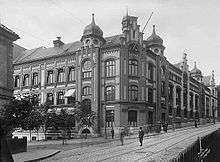Oslo Cathedral School
Schola Osloensis, known in Norwegian as Oslo katedralskole (Oslo Cathedral School) and more commonly as "Katta",[1] is a selective upper secondary school located in Oslo, Norway. The school offers the college preparatory studiespesialisering (literally: specialization for studies) of the Norwegian school system. Oslo Cathedral School is one of four schools in Norway which can trace its origins directly to the Middle Ages and is generally regarded as one of the most prestigious schools in Norway. It celebrated its 850-year anniversary in 2003.[2]
| Oslo Cathedral School | |
|---|---|
 Coat of arms | |
| Location | |
Oslo Norway | |
| Coordinates | 59°55′16″N 10°44′29″E |
| Information | |
| Type | Upper secondary school |
| Established | 1153 |
| Head of school | Eva Blomfeldt |
| Grades | VG1 - VG3 |
The school's motto is the Latin phrase Non scholae, sed vitae discimus (We do not learn for the sake of the school, but for the sake of life),[1] in contrast to the former motto; Non vitae, sed scholae discimus (We do not learn for the sake of life, but for the sake of the school).
History
According to tradition, the school was founded in 1153 by papal delegate Cardinal Nicholas Breakspeare, and administered by the Cathedral of Saint Hallvard.[3] From its foundation and until the 18th century the school was primarily a school for educating priests. Thus, the school's teaching traditions was from the start that of the Roman Catholic Church. As with most of Europe at the time, lessons were based on an educational curriculum known as the Liberal arts. This curriculum consisted of seven different subjects the students were required to learn, and they were ordered in two groups: Trivium and Quadrivium. The Trivium (Latin for three ways) comprising the three subjects that were taught first, grammar, logic, and rhetoric. After Trivium followed the Quadrivium (Latin for four ways), being geometry, arithmetic, music, and astronomy. The language used was Latin and remained so until the 18th century. Unlike most other Norwegian state schools, Latin is still being taught at the school today.
The 17th century is in the school's history known as "Det lærde århundre"[4] (literally the learned century), because some of the school's teachers were among the most educated scholars in Norway at the time. After a great fire destroyed much of Oslo in 1624, the city was relocated and reconstructed, forcing the school to change location. After a new gymnasium was opened in Christiania (Oslo's name until 1878), students were offered lessons in extracurricular subjects, including astronomy, philosophy, physics and metaphysics.

During the end of the 18th century, several reforms were implemented in Norwegian Latin-schools. The students' mother tongue was finally given room in the lessons, Natural science was given more priority and school libraries were established. Disciplinary punishment was only to be used if it could not be avoided and ideas from the contemporary Age of Enlightenment were also implemented, one of them being the encouragement of students to do their best[3]
The tradition of Latin being mandatory was abolished in 1869 and students were given the opportunity between a three-year-long school run with either Latin or natural sciences.
During World War II, parts of the school building were employed by the German occupants, though teaching continued as usual. Several of the teachers were however involved in resistance activities against the Germans. One of the central figures of this resistance was caught while escaping to Sweden and subsequently committed suicide in prison to avoid being coerced into revealing the resistance's activities.
Eva Blomfeldt has been headmaster since 2013.
Some headmasters
Notable alumni of international interest
- Caspar Wessel (1745-1818), Mathematician
- Niels Henrik Abel (1802-1829), Mathematician
- Henrik Wergeland (1808-1845), Poet
- Johan Sverdrup (1816-1892), Prime Minister of Norway
- Johannes Irgens (1869 - 1939), Minister of Foreign Affairs
- Otto Bahr Halvorsen (1872-1923), Prime Minister of Norway
- Edvard Munch (1863-1944), Painter
- Otto Ruge (1882-1961), General, Commander-in-chief of Norwegian Armed Forces 1940
- Arne Sunde (1883-1972), President of the United Nations Security Council 1949 and 1950
- Rolf Nordhagen (1894-1979), botanist
- Trygve Haavelmo (1911-1999), Professor in Economics, recipient of the 1989 Nobel Prize in Economics
- Astrid Nøklebye Heiberg (1936-), Former Minister of Administration and Consumer Affairs, former President of the International Federation of Red Cross and Red Crescent Societies
- Harald V (1937-), King of Norway
- Johan Jørgen Holst (1937-1994), Minister of Foreign Affairs and Minister of Defense
- Egil Kraggerud (1939-), Philologist
- Jon Elster (1940-), Philosopher and social scientist, professor at Columbia University and Collège de France
- Arne Treholt (1942-), Diplomat, convicted of espionage in 1985
- Mads Gilbert (1947-), Doctor and humanitarian worker
- Jostein Gaarder (1952-), Author
- Erik Solheim (1955-), Diplomat, Former Minister of the Environment and International Development
- Jens Stoltenberg (1959-), Secretary General of Nato (from October 1, 2014), Former Prime Minister of Norway
- Kjetil Try (1959-), Advertising agency executive and crime fiction writer
- Erling Kagge (1963-), Explorer and publisher
- Espen Barth Eide (1964-), Former Minister of Foreign Affairs
- Thomas Seltzer (1969-), Musician (Turbonegro), TV Talk Show Host
- Anders Danielsen Lie (1979-), Actor, Musician, Physician
See also
- List of the oldest schools in the world
References
- Oslo katedralskole | About the school Archived 2006-05-08 at the Wayback Machine
- Oslo katedralskole | Jubileumssider Archived 2007-12-15 at the Wayback Machine
- Oslo katedralskole | Historie Archived 2007-12-30 at the Wayback Machine
- Ernst Bjerke: En historikk Archived 2014-04-19 at the Wayback Machine (See "Historie") (in Norwegian), Oslo Katedralskole, retrieved December 11, 2012